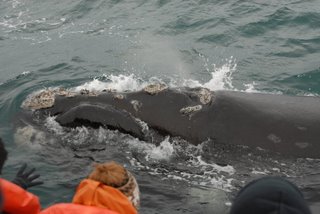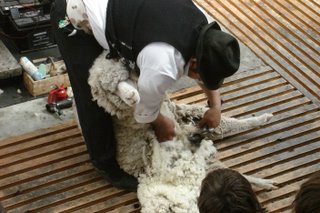A Typical Week - Although it could be said that in an international program, there is no such thing as a typical week, there is a bit of a routine for each week. I teach two classes, and the Human Genetics class meets on Monday, Tuesday and Friday mornings, and the Science and Religion class meets on Tuesday and Friday mornings and Wednesday afternoons. After classes on Wednesday, everyone meets at the Casa for convocation [usually a time of worship songs and a presentation, e.g. the US Ambassador will soon be coming to a convo], and then we all go out for a group dinner. Dinners are at various restaurants and thus far have included Greek with a dance show, Italian with an operetta show, International with a tango show, and Norteamericano with no show - just great food and swift service. Thursdays, I do not have any classes, and there is a noontime asado at the Casa for everyone. On Thursday evenings, volunteers go to a Catholic church facility to prepare sandwiches for the families of hospitalilzed children. There usually are about a dozen students who show up - Rhonda and I help out at the church, and then the students take the food to a hospital and meet with the families, sing songs and play games. Many of the weeks are punctuated with special events, such as sports days with some of the local schools, long weekends for travel time, field trips, and a spiritual retreat that is coming up this Friday through Sunday. When I am not grading homework and tests, or preparing for classes, we try to get out and about to explore the city, visit various barrios and browse at the many ferias. Rhonda has been doing a "good job" of browsing rather than buying :-) She has time for reading, Sudoku, and the internet. She also is 'mother on call' for the 51 students, and is a real heroine when she whips up some homemade dishes and desserts to share with the students and staff. "Mrs. S., you are soooooooo awesome" is a common quote when Rhonda is working in the kitchen.
Cultural Adjustments - Some folks have asked us what we miss, and aside from the obvious such as family and friends, it is not that we are missing a lot, but rather it is getting used to a different way of life. Such as no car. When we left the USA, we got out of the auto market [no insurance payments, no license fees], and here, we get around almost exclusively by walking and riding the subte. This past Sunday, we rode the bus, and last Friday evening, we took a taxi to the Teatro Colon. And, it was not really a 'taxi' but rather was with Andres, a driver who does a lot of hired driving for Pepperdine in Buenos Aires. For example, we hired Andres to take Rhonda to the airport last Thursday to pick up our good friend Arlene Cook from Colorado Springs, and we will probably hire Andres to go to the airport when our kids come to visit. Rhonda recently noted that "riding in a car is like a special treat," although we certainly do not need and indeed do not want a car. One of our car-savvy students notes that there are models here that are not available in the USA, e.g. the Toyota Hilux truck and SUV, the Mercedes 200C and A class, and the Chevrolet Astra, Vectra and Corsa.
One interesting difference that we noted rather quickly was that there are no window or door screens at the Casa, and possibly in all of Argentina! It is great to have everything open for the buenos aires, but it is thus also open to the pests, notably the mosquitoes [totaly random aside, speaking of mosquitoes and 'good air' what disease was named after 'bad air'?]. Another thing that we noted was the large number of stray cats and dogs, and the large number of dogs with owners. All of this makes one very conscious of where one walks on the sidewalks and in the parks. It is also very clear that we are living in a very large city - about one third of the 39 million people in Argentina live in Buenos Aires, or as it was originally known, Ciudad de la Santísima Trinidad y Puerto de Santa María de los Buenos Aires, "City of the Most Holy Trinity and Port of Saint Mary of the Fair Winds." The population of 13,000,000 places Buenos Aires in 12th place among the largest urban areas in the world, and thus there are all of the attendant mega-city characteristics, good and bad - the "Paris of South America" with all of the cultural amenities; street trash and noise around the clock; great public transportation; poverty; and the list goes on as you can imagine.
Skype - Thank goodness for Skype! This free voice-over-internet software makes it possible to talk computer to computer for free, and from our computer to USA phones for 2.1 cents per minute. And, the quality of communication is generally quite good. So, between Skype and the internet, we feel like we are fairly connected to the folks back home. And, of course this blog helps us to connect to those of you who take a moment to read it!! Drop us an email sometime, and buen dia.








